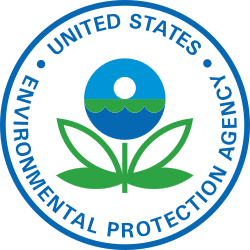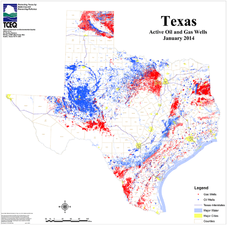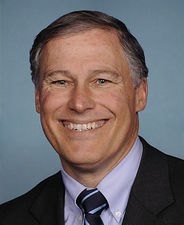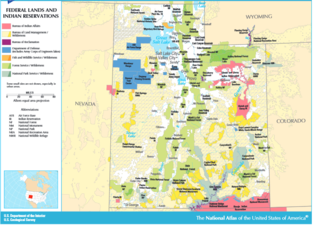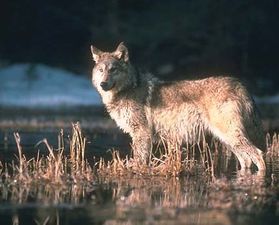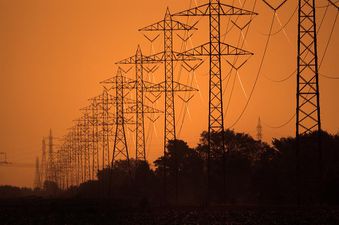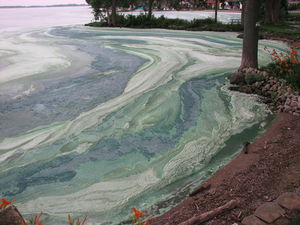It’s the 12 Days of Ballotpedia! Your gift powers the trusted, unbiased information voters need heading into 2026. Donate now!
The Policy Tracker: Energy and Environment: January 2015
The Environmental Policy Project produces this weekly Policy Tracker: Energy and Environment to report on major national and state environmental issues, including land ownership, energy production, air and water regulations, endangered species, pollution and much more.
January 26, 2015
Tennessee approves $2 billion energy transmission line
The proposed Plains and Eastern Clean Line is a 700-mile transmission line that would carry 3,500 megawatts of electricity from future wind farms in Oklahoma and Texas to western Tennessee. The plan was developed by Clean Line Energy, a Houston-based energy company and is expected to cost $2 billion. According to Mario Hurtado, a co-founder and the executive vice president of development for Clean Line Energy, the transmission line could deliver electricity to Tennessee at 4.3 cents per kilowatt hour and make the price of wind energy competitive with other sources of electricity, such as natural gas and coal. Michael Skelly, the president of Clean Line Energy, stated that the project would deliver renewable energy and help diversify utilities' portfolios. "The development of this important infrastructure project is an essential role that affordable renewable energy can and should play in the energy mix for Tennessee and the greater Southeast," Skelly said in an interview.[1]
In December 2014 the U.S. Department of Energy (DOE) issued a 3,700-page environmental impact statement for the project after conducting roughly 18 months of meetings with state, local and federal officials and affected citizens. The DOE's report highlighted the potential impact of the project on agriculture, health and safety issues involving electrical and magnetic fields, and the impact on private land ownership. The report also found that, if approved, the project could create an average of 965 jobs over a 36 month to 42 month period during its construction, with peak employment of 1,700 workers during that period. After construction, the project is estimated to create 72 to 87 full-time jobs. The department plans to accept public comments on the report until March 19, 2015. Public meetings will occur in towns in Oklahoma, Texas, Arkansas and Tennessee before that date. The DOE is expected to publish a final report and recommendation in late 2015.[2][3]
In January 2015 the Tennessee Regulatory Authority approved the Clean Line Energy project for construction, which may begin in as soon as 2016. The project is still awaiting approval from the U.S. Department of Energy and Arkansas regulators. Arkansas' congressional delegation wrote to Energy Secretary Ernest Moniz on January 24, 2015, requesting more time for public comments on the project's environmental impact. "We understand the importance of infrastructure projects, including properly-sited transmission lines, but we also believe that potentially-impacted landowners and citizens must be treated fairly and they must have every opportunity to eliminate or minimize impacts before projects are considered. In short, private property rights must be protected. Accordingly, we request that you provide at least a 60-day extension of the comment period for the...Plains & Eastern Clean Line Transmission Project," the letter said.[4]
Connecticut seeks public comments on the first state park in 50 years
- See also: Environmental policy in Connecticut
In October 2014, Governor Dannel Malloy announced a plan to create a shoreline state park in New London County, the first state park in 50 years. The plan creates a state park from a 32-acre property in Waterford, Connecticut, called "Seaside." "This is a beautiful piece of land that should be used for the direct benefit and enjoyment of the residents of Waterford and the State of Connecticut," Malloy said in his announcement. "We now have an opportunity reassess the future of this property and allow the people of Connecticut to enjoy its natural beauty for generations." In 2010, the state signed a contract with a private company to develop the area into a state park, but in October 2014, the Connecticut Department of Administrative Services terminated the contract. Malloy directed the DEEP and other state agencies to calculate the costs of converting the property into a state park.[5]
On December 15, 2014, the Connecticut Department of Energy and Environmental Protection held its first public information meeting on the new park, the first of three town hall events to be held in early 2015 before the proposed park receives a preliminary final plan ready for review by April 2015. The plan will address what to do with old sanatorium buildings found throughout the area. The buildings were constructed in the early 1930s and are listed on the National Register of Historic Places, and could be potentially rehabilitated, reused or demolished. The final plan must also address shoreline preservation and improving the area's ecology. The Connecticut Department of Energy and Environmental Protection is seeking public comments via email on the proposed park, including how it could be used and whether the site's historic buildings should be maintained.[6][7]
Ohio receives a federal grant to address toxic algae
- See also: Environmental policy in Ohio
Several Midwestern states, including Ohio, see harmful algal blooms in lakes, rivers and streams due to phosphorus runoff from farms. Ohio has received a new federal grant of about $12 million for farm conservation, targeted at reducing runoff that puts phosphorus into western Lake Erie and feeds harmful algal blooms. In January 2015 the U.S. Department of Agriculture (USDA) announced that $17.5 million in federal grants would be given to the Tri-State Western Lake Erie Basin Phosphorus Reduction Initiative, a plan to reduce phosphorous nutrients from water sources. The grants would fund technical assistance to farmers to reduce phosphorous nutrient runoff and water quality monitoring of water sources vulnerable to the sediment and nutrient build up that produces toxic algae. Ohio is set to receive 70 percent of the proposed funding because of its large agricultural sector, while Indiana and Michigan are set to receive 12 percent and 18 percent of the funding, respectively.
State funding for the monitoring of streams for toxic algae and invasive Asian carp was approved by the Ohio Controlling Board back in December 2014. The request was submitted by the Ohio Environmental Protection Agency and installed 14 stream gauges in five Ohio counties at a cost of $548,900. The monitoring would mostly collect "long-term data on nutrient and sediment loads and stream flow" to assess how the Ohio state government can assist in reducing excess phosphorous in Ohio streams and lakes.[8]
January 19, 2015
The Great Lakes wolves receive endangered species protections
- See also: Endangered Species Act
In December 2014 a federal judge on the U.S. Court of Appeals for the District of Columbia ordered gray wolves in the Great Lakes area to receive endangered species protection. This decision affects Minnesota, Wisconsin and Michigan where gray wolves are common. The decision forbids the hunting of gray wolves, a controversial issue in Minnesota and Wisconsin. The ruling lists the gray wolf as a "threatened" species in Minnesota and an "endangered" species in Wisconsin and Michigan, under the management of the U.S. Fish and Wildlife Service. Under the Endangered Species Act, a threatened species may be killed in self-defense but not for the protection of livestock or pets. Endangered species receive stricter habitat protections, with the goal of creating a more sustainable population.[9]
The decision marks a shift in policy for the Great Lakes wolves. The U.S. Fish and Wildlife Service (USFS) has tried to remove the wolves from the list of endangered species four times since 2003. The USFS argued that the wolves had recovered to "sustainable levels" as required by law, but the USFS was blocked by lawsuits from environmental groups. In 2012 the service finally removed the wolves from the endangered species list, making state governments responsible for Great Lakes wolves. In February 2014 the Humane Society and other animal welfare organizations filed suit against the service to reverse the "de-listing" of the wolves, which succeeded in the December 2014 federal decision.[9]
The status of the Great Lakes wolves has generated controversy. According to the Humane Society's chief counsel and senior vice president, Jonathan Lovvorn, over 1,500 wolves were hunted and killed in Minnesota and Wisconsin since 2011. Minnesota and Wisconsin hosted at least three wolf hunts in December 2014 alone. One hunt in Minnesota's ended with the killing of 272 wolves. Although Michigan scheduled a wolf hunt, the decision was overturned by voters in a November referendum. In a statement for the Humane Society, Lovvorn said, "We are pleased that the court has recognized that the basis for the de-listing decision was flawed, and would stop wolf recovery in its tracks."[9] Joining the Humane Society in the lawsuit was Born Free USA, Help Our Wolves Live and Friends of Animals and Their Environment.
In response several members of Congress, including Representatives Reid Ribble of Wisconsin, Collin Peterson of Minnesota, Dan Benishek of Michigan, and Cynthia Lummis of Wyoming, introduced legislation to reverse the decision and keep the Great Lakes wolves off the endangered species list.[10]
A potential gold mine in the Highlands of Montana clears an environmental hurdle
- See also: Environmental policy in Montana
In December 2014 the Montana Department of Environmental Quality published a final Environmental Impact Statement for a proposed gold mine south of Butte, Montana in the Montana Highlands. The statement was another step forward for the mine's ultimate approval. The bulk of the statement addressed whether the mine's operations, including its closing, would cause long-term environmental problems to Basin Creek, which flows into the Boulder River. According to the report, the proposed mine could change water flows into Basin Creek, potentially disrupting natural water flows, but the report determined the waters would reverse back to their natural paths. "The hydrology of that area would return to what it was before there was ever a mine there," said Montana Environmental Policy Act Coordinator Kristi Ponozzo said. "This is a step toward the mine being potentially permitted."[11]
According to the mine developers, the mine will have several economic benefits. The area has an estimated ore deposit of nearly 200,000 ounces of gold, while other mine developers have said that there could be significantly more ounces based on preliminary exploration of the proposed area. The project is also expected to create around 50 jobs. The Montana Department of Environmental Quality must still issue a ruling on another permit before the end of January 2015, while the U.S. Forest Service must still approve routes for hauling equipment by May 2015 before the project receives final approval.[11]
A federal judge could halt the nation's first GMO labeling law in Vermont
- See also: Environmental policy in Vermont
In 2013 the Vermont State Legislature passed legislation to require labels for genetically-modified organisms and ingredients (GMOs) in food products sold to consumers. It was the first state to pass a law requiring GMO labeling. Although the law does not ban food products with GMOs, it does require food manufacturers and retailers to put labels on food products that contain any processed ingredients from genetically engineered sources such as some types of corn. Processed foods made partially or entirely from GMOs would be required to have labels stating if the products were ""produced with genetic engineering," "partially produced with genetic engineering" or "may be produced with genetic engineering. Accurate food labels are required for certain food products after July 1, 2016.[12][13]
In January 2015 a federal judge heard arguments about whether or not to reverse Vermont's GMO labeling law. The lawsuit, brought by the Grocery Manufacturers Association, argued that the law should be suspended until it was determined to be constitutional. The state of Vermont argued that the lawsuit should be dismissed. Judge Christina Reiss asked the state's attorneys how valuable the law was if a food manufacturer could simply put the label on its products regardless. The judge also asked the state how informative the labeling law was when nearly 90 percent of corn and a large percentage of other commodities are genetically engineered.[14] Reiss made it clear that the case was not about whether GMOs are harmful to human health or the environment but whether the law should be upheld as constitutional or not. "I am confident it is not my job to determine if genetically engineered foods are safe or unsafe," Reiss said during the hearing on January 7, 2015.[14]
Although the law will not go into effect until July 1, 2016, several large food manufacturers such as ConAgra Foods may have to begin changing their labels immediately in order to comply with law.[14]
January 12, 2015
Nebraska and Kansas sue U.S. Environmental Protection Agency over ethanol rules
- See also: Ethanol, Energy policy in Nebraska and Energy policy in Kansas
In December 2014 Kansas and Nebraska sued the U.S. Environmental Protection Agency (EPA) over the revision of the Motor Vehicle Emission Simulator (MOVES), which determines which pollutants are emitted by motor vehicles, including greenhouse gases and toxic air particles. The lawsuit was filed in the U.S. Court of Appeals for the D.C. Circuit by Kansas Attorney General Derek Schmidt and Nebraska Attorney General Doug Peterson. The lawsuit argued that the EPA did not provide an opportunity for comment and review by the states, and that the regulation would unfairly target emissions from ethanol, discouraging its use by states to meet air quality standards.[15]
Under the Clean Air Act states must comply with federal air standards and document their compliance. States with significant ethanol production, such as Nebraska and Kansas, have air standards which take into account ethanol-blended gasoline. The 2014 MOVES system, however, takes into account gasoline with higher concentrations of ethanol, such as E-20 and E-85 fuel, and assumes that these high-ethanol fuels produce more emissions, thus requiring Nebraska and Kansas to implement stricter air quality standards. Non-compliance with federal air standards could affect the states’ qualification for federal highway and transportation funds, according to the Lawrence Journal-World.
The lawsuit argued that the regulation unfairly targets emissions from ethanol and thus discourages the use of ethanol by states as part of their state clean air plans. "Ethanol production is an important industry for Kansas and grain agriculture specifically," said Schmidt, the Kansas Attorney General. "EPA's requirement that states use this faulty model was unlawfully adopted without notice and opportunity for comment. This is an example of the EPA imposing its will on the states rather than working cooperatively toward the shared goal of cleaner air. We are asking that this model be rejected and replaced with a model that more accurately reflects the true emission effects of ethanol," he added. The lawsuit was joined by two pro-ethanol groups, the Urban Air Initiative Inc., and the Energy Future Coalition. [16]
Texas earthquakes and fracking
- See also: Fracking in Texas
Increased oil and natural gas drilling in Texas has brought an increase in the number of disposal wells, which serve as underground storage for waste created during the drilling process. The Texas Railroad Commission, which regulates the state's oil and gas activity, approved 668 disposal well permits in 2013, double the number of permits approved in 2009. In October 2014 the commission amended its rules on disposal wells due to concerns that earthquakes could be triggered by high-pressure injection wells. Under the new rules, if a company seeks to drill in Texas, it will have to review data published by the U.S. Geological Survey around the proposed site. If the site has a history of seismic activity, state regulators may require additional data from the company. The rules also allow the commission to shut down or halt an injection well if it determines the well may trigger an earthquake. "These comprehensive rule amendments will allow us to further examine seismic activity in Texas and gain an understanding of how human activity may impact seismic activity," said Commissioner David Porter, "while continuing to allow for the important development of our energy resources in Texas." The U.S. Environmental Protection Agency (EPA) supported the rules as well.[17][18]
The issue of fracking, disposal wells and potential earthquakes came to the forefront on January 5 and 6, 2015, when northern Texas, including Dallas, experienced a series of nine earthquakes within a 24-hour period. The earthquakes sparked concerns that recent oil and gas activity, including fracking, contributed to the earthquakes, which are rare in Texas. According to Brian Stump, a Southern Methodist University professor and seismologist, it was “premature to speculate on the causes of the earthquakes.”[19] Southern Methodist University announced it would install 22 more seismographs throughout the Irving area but stated that studying the causes of the North Texas earthquakes would require time.[19][20]
Fracking and its potential connection to seismic activity are not restricted to Texas. In March 2014 small earthquakes struck areas near Youngstown, Ohio, where fracking occurred. According to at least one study, published by the Bulletin of the Seismological Society of America, scientists linked the practice of fracking to the small quakes in that area of Ohio.[20][21]
Washington State climate change initiatives
In April 2014, Washington Governor Jay Inslee issued an executive order detailing a list of policies to combat climate change, reduce carbon emissions and promote the use of clean energy. The order contained seven areas in which the state government would act, including:[22]
- Carbon emissions: A Carbon Emissions Reduction Task Force is responsible for designing and implementing a carbon reduction program based on market principles.
- Coal-fired electricity: Washington State agencies are required to work with utility companies to reduce and eventually eliminate electrical power produced by coal.
- Clean transportation: The Washington Department of Transportation is required to coordinate with other state agencies to support clean fuel industries, including electric automobiles.
- Clean technology: The Washington Department of Commerce is charged with working with Washington State University on a program for new renewable energy and energy efficiency technologies with an emphasis on solar power.
- Energy efficiency: The Washington Department of Commerce is directed to monitor energy performance of public and private buildings.
- State government operations: The Washington Department of Enterprise Services will supervise the reduction of carbon and energy efficiency improvements throughout state government offices.
- Carbon pollution limits: The state Department of Ecology will review the state’s greenhouse gas emission limits and recommend updates.
The executive order also established the Carbon Emissions Reduction Taskforce (CERT), 21-member panel of business, health, labor and nonprofit organization members from around the state that provide recommendations to the governor of Washington on a market-based, carbon pollution program.[23]
Inslee announced further proposals for carbon reductions in December 2014, including a carbon tax on major greenhouse gas emitters that is expected to raise approximately $4.8 billion over a 12-year period. These emitters include the state's largest businesses and industries. A portion of the revenue is slated to fund infrastructure projects and road maintenance projects, but the revenue will also provide incentives for clean energy-related projects like electric cars, public transit systems and new electric vehicle charging stations.[24][25]
Des Moines lawsuit over river pollution
Des Moines, the largest city in Iowa, is suing three neighboring counties for high levels of nitrate particles in the Raccoon and Des Moines rivers. The Raccoon River in particular saw the highest level of nitrates since water quality testing began. Nitrate particles in water does have known health risks, including to infants under six months of age, and is difficult to remove from water. High-nitrate water can also kill off aquatic life. In 2013 the city's water utility, the Des Moines Water Works, paid $900,000 to filtrate nitrate out of the water. Due to current regulations, however, some of the nitrates that were filtered out of the water were released back into the water system. According to the utility's general manager, Bill Stowe, the source of nitrate pollution is the farms using nitrogen fertilizer in crop fields. When this fertilizer is used, nitrate is formed and flows through underground pipes and runs off into streams. Drainage systems carrying high-nitrate water are typically managed by county governments, which provided the legal basis for Des Moines' lawsuit, because these governments could be held legally responsible for the nitrate-polluted water. "When they build these artificial drainage districts that take water, polluted water, quickly into the Raccoon River, they have a responsibility to us and others as downstream users," Bill Stowe said to Iowa Public Radio. The counties in question are Sac County, Calhoun County and Buena Vista County.[26][27][28]
The topic of nitrogen fertilizer is important to the environmental policy in that it goes largely unregulated. According to one Iowa farmer, nitrogen fertilizer is a necessary component in producing corn. "As a grain farmer, we need nitrogen fertilizer for corn production. If our usage of that is curtailed, it would make corn production nonprofitable," Kevin Larson, a Story County farmer, said.[27] According to Stowe from Des Moines Water Works in an interview for KCCI News, "There's a big difference between people who apply nitrates to their soils to generate a profit versus those of us who inherit water that's nitrate-laden have to clean it."[27]
One organization, the Iowa Soybean Association, supported the counties in an official statement: "Claims by Des Moines Water Works that we have a water quality crisis in Iowa is sensationalistic at best and worst dishonest. There is not a trend of rising nitrates levels in the Raccoon River."[28] The Des Moines Water Works issued a 60 day notice before it plans to move forward with legal action against the counties in question.[28]
January 5, 2015
Utah transfer of federal lands
In 2012 Utah Governor Gary Herbert signed Utah House Bill 148 into law, which demanded the transfer of more than 20 million acres of federal land back to the Utah state government. Once land ownership is transferred into Utah’s hands, the state government would begin to collect 5 percent of all revenue generated from the land while 95 percent of revenue would still go to the federal government. The 2012 bill set a deadline of December 31, 2014 for the transfer of lands. That deadline was not met and Utah is now expected to pursue a strategy of "education, negotiation, legislation and litigation," although official responses from the Utah state government or the relevant federal agencies have yet to be released.[29]
The legality of Utah’s actions is hotly debated. The law’s supporters have argued that the federal government’s ownership of these lands was only meant to be temporary. Specifically, supporters said that an 1894 federal statute called the Enabling Act required to the federal government to transfer these lands back to Utah after it became a state. Opponents of the law have argued that only Congress can say whether or not land belongs to the federal government. The issue could end up in the judiciary.[30]
The economic consequences are also debated. Governor Herbert has stated that federal ownership of these lands has crippled new sources of revenue for education, since state and local property taxes cannot apply to federal land. A team of economists from University of Utah, Utah State University, and Weber State University published a study showing that the transfer is economically feasible, but only if gas and oil prices remain stable and energy production remains on pace with recent production. The study also found that the transfer would cost the state $245 million annually, a third of which would go toward fire suppression and fuel management. The state would also lose roughly $35 million in federal Payments in Lieu of Taxes (PILT), which offset the property taxes lost by counties because of federal land ownership.[30]
In January 2015 the federal solicitor of the Utah attorney general’s office announced the draft for a potential lawsuit but did not specify a timeline for the lawsuit. According to the Associated Press, the Utah state legislature created a $2 million fund for the state’s attorney general if a lawsuit goes forward. The U.S. Department of the Interior is responsible for managing these Utah lands, but a department spokesperson was quoted as saying the department "has made it clear that it's a waste of time and resources for Utah to debate" the land transfer.[31]
Keystone XL pipeline
Congressional Republicans are expected to move quickly on legislation to expedite the Keystone XL pipeline.[32] If approved, several states are likely to be affected by the pipeline. Keystone XL is owned by TransCanada Corp., a large Canadian energy company, and would be an expansion of an oil pipeline carrying crude oil from Alberta to refineries in the United States along the Gulf of Mexico.[33]
Supporters of the expansion tout the number of jobs the pipeline is predicted to create; in addition the pipeline is expected to reduce the United States’ dependence on foreign oil. Opponents have stated that the pipeline would only further aggravate climate change through the use of carbon-intensive forms of oil like oil sands.[33]
TransCanada estimated the creation of 20,000 jobs as a result of the expanded pipeline, while the U.S. State Department estimated the creation of 42,000 jobs. On the other hand, the U.S. State Department also estimated that the pipeline would increase greenhouse gas emissions by 27.4 million metric tons per year, or the equivalent to the annual emissions of 5.7 million passenger vehicles.[33]
The pipeline could also transfer 830,000 barrels of crude oil per day, or the equivalent of 10 percent of current U.S. production and roughly 5 percent of the United States' daily consumption of crude oil. One part of the proposed expansion, connecting Oklahoma to the Gulf Coast of Texas, near which there are numerous oil refineries, could bring roughly 700,000 barrels of oil a day to Texas oil refineries.
The U.S. Senate’s Committee on Energy and Natural Resources, which is controlled by Republicans, will hold a hearing on the Keystone XL pipeline on January 7, 2015.[33]
Crude oil transportation in North Dakota
- See also: "Fracking in North Dakota"
The Bakken Shale, a large area covering eastern Montana and western North Dakota, is responsible for a large portion of U.S. oil production, particularly in North Dakota. The oil that is extracted is transported by rail, increasing rail transportation significantly as oil extraction has expanded in the Bakken Shale. According to the Wall Street Journal, each day 1.1 million barrels of oil are transported by railroad across the United States. Crude oil from North Dakota is transferred to American refineries in other parts of the country, including the Western United States and the Gulf Coast.[34]
In July 2013 a deadly accident in Quebec killed 47 people after oil trains, which contained crude oil taken from the Bakken, derailed and exploded. In response the North Dakota Industrial Commission issued regulations requiring energy companies to make its crude oil less volatile and safer for railroad transportation. The rules are a response to several trains that have derailed and exploded because of the volatile gases. Energy companies in North Dakota, which are primarily pumping oil from shale, are required to strip explosive gases from crude oil production and to process crude oil with new equipment to burn off these gases. The rule will go into effect on April 1, 2015.[34]
The regulations are the first for any state or federal regulator of oil to require safer oil transportation. Under the North Dakota rules, oil cannot be transported unless it is below a certain vapor pressure level. The oil must also be heated to a minimum of 110 degrees, which would require the installation of new equipment. The costs of these rules have not yet been published by the North Dakota Industrial Commission.[34]
The Obama administration is expected to release new rules in 2015 governing the transportation of crude oil by rail, in addition to eight other new rules for the oil and natural gas industry.[35]
Coal ash rules from the U.S. Environmental Protection Agency
The U.S. Environmental Protection Agency (EPA) finalized its regulations on the disposal of coal combustion residuals (CCRs), commonly known as coal ash, which are produced by coal-fired power plants. The regulations contain requirements for coal ash landfills and seek to address the health risks of coal ash disposal, including contaminants leaking into groundwater sources and blowing in the air. The regulations require companies to follow new recordkeeping and reporting rules on their coal ash. They also require these companies to post this information on a public website. According to the Washington Post, the coal ash regulations represent the first federal regulations on coal ash disposal.[36][37]
North Carolina in particular has seen coal ash as a major environmental issue. Coal ash is stored in 14 facilities throughout the state. In February 2014, 39,000 tons of coal ash, from a broken pipe at a defunct power plant, spilled into the Dan River near Eden, North Carolina. The plant was owned by Duke Energy, a major energy company in the state. State lawmakers responded in September 2014 by passing the Coal Ash Management Act, which passed without the signature of Governor Pat McCrory. The law requires the clean up of four of the total 14 coal ash storage sites in the state. The other 10 sites were prioritized based on the amount of environmental damage done and are scheduled to be cleaned up and closed over a 15 year period. The law also requires Duke Energy to clean up coal ash at four sites. Environmental activists have argued that the law does not go far enough to repair leaks at all 14 of the coal ash storage sites and that leaks could still contaminate groundwater systems.[36][37]
See also
- Environmental policy in the United States
- Environmental Policy
- Energy policy in the United States
- State environmental policy pages
- Energy Policy
Footnotes
- ↑ Times Free Press, "TRA approves Clean Line Energy to bring wind power to TVA," January 15, 2015
- ↑ News OK, "Federal officials release draft report on Plains and Eastern Clean Line transmission project," December 12, 2014
- ↑ Times Free Press, "FERC approves Clean Line to transmit wind power from Oklahoma to Tennessee," August 20th, 2014
- ↑ Times Record, "Arkansas Delegation Seeks More Public Comment Time for Clean Line Project," January 24, 2015
- ↑ New Canaan Daily Voice, "Connecticut Looks To Add A New Shoreline State Park," October 5, 2014
- ↑ Hartford Courant, "State Holds Hearing On Seaside State Park Plans," December 16, 2014
- ↑ WTNH News, "State officials looking for your input on new Waterford park," January 15, 2015
- ↑ The Gateway News, "Ohio controlling board OKs monitoring streams for toxic algae," December 15, 2014
- ↑ 9.0 9.1 9.2 Minnesota Public Radio, "Great Lakes wolves ordered returned to endangered list," December 19, 2014
- ↑ Associated Press, "Bill would remove federal protections for wolves in 4 states," January 12, 2015
- ↑ 11.0 11.1 The Montana Standard, "Proposed Highlands gold mine clears hurdle," December 19, 2014
- ↑ Vermont Right to Know GMOs, "About the VT Right to Know GMOs Campaign," accessed December 12, 2014
- ↑ Vermont Digger, "Vermont food producers prepare for GMO labeling," November 9, 2014
- ↑ 14.0 14.1 14.2 Burlington Free Press, "Judge considers halting Vermont GMO law," January 7, 2015
- ↑ U.S. Environmental Protection Agency, "EPA Releases MOVES2014 Mobile Source Emissions Model," July 1, 2014
- ↑ Midwest Producer, "Kansas, Nebraska attorneys general challenge EPA ethanol emissions model," December 15, 2014
- ↑ Star-Telegram, "Texas Railroad Commission adopts tighter rules for disposal wells," October 28, 2014
- ↑ Dallas News, "Texas Railroad Commission tightens drilling-waste disposal rules after earthquake scare," October 28, 2014
- ↑ 19.0 19.1 National Geographic, “Are Oil and Gas Industries Behind the Rare Texas Earthquakes?” January 7, 2015
- ↑ 20.0 20.1 KUT News, “After 12 Quakes in 2 Days, Scientists Deploy More Seismographs in Irving,” January 9, 2015
- ↑ Bulletin of the Seismological Society of America, “Earthquakes Induced by Hydraulic Fracturing in Poland Township, Ohio,” January 6, 2015
- ↑ Governor of Washington's Office, "Governor Inslee's Executive Order 14-04: Washington Carbon Pollution Reduction and Clean Energy Action," April 29, 2014
- ↑ Governor of Washington's Office, "Carbon Emissions Reduction Taskforce," accessed November 24, 2014
- ↑ Governor of Washington's Office, "Gov. Inslee calls for comprehensive statewide transportation program," December 16, 2014
- ↑ Think Progress, "Gov. Inslee Wants To Cap And Tax Emissions From Washington State’s Major Polluters," December 17, 2014
- ↑ National Public Radio, "Iowa's Largest City Sues Over Farm Fertilizer Runoff In Rivers," January 12, 2015
- ↑ 27.0 27.1 27.2 KCCI News, "Des Moines Water Works plans to sue three counties over nitrates," January 11, 2015
- ↑ 28.0 28.1 28.2 Siouxland Matters, "Siouxland Counties Could Face Suit over Nitrate Issues in Des Moines," January 9, 2015
- ↑ St George News, Deadline for public lands transfer passes, state considers litigation," January 3, 3015
- ↑ 30.0 30.1 Salt Lake City Tribune, "Economist: Transferring federal lands could generate revenue for Utah," December 1, 2014
- ↑ Magic Valley, “Utah Gears Up for Federal Lands Fight as Deadline Passes,” January 5, 2015
- ↑ The New York Times, "Republicans Say They'll Act Fast to Push Agenda," January 4, 2014
- ↑ 33.0 33.1 33.2 33.3 Bloomberg, "Senate Republicans set hearing to approve Keystone XL measure," December 31, 2014
- ↑ 34.0 34.1 34.2 The Wall Street Journal, "Oil Trains Hide in Plain Sight," December 3, 2014
- ↑ The Wall Street Journal, "Oil and Gas Regulatory Push Coming from Obama Administration," December 30, 2014
- ↑ 36.0 36.1 U.S. Environmental Protection Agency, "2014 Final Rule: Disposal of Coal Combustion Residuals from Electric Utilities," December 19, 2014
- ↑ 37.0 37.1 Washington Post, "The EPA's Move to regulate 'coal ash' is a step forward," January 1, 2015
| ||||||||||



